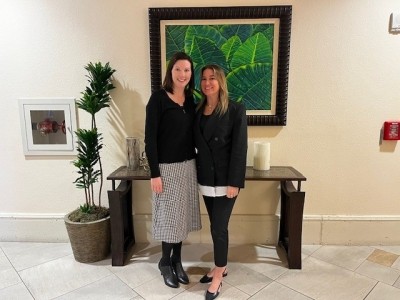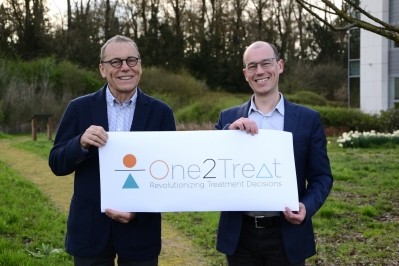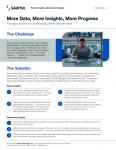Prioritizing women, promoting diversity and a patient-first approach - how does CTM do it?

It was an insightful and interesting discussion about feeling close to patients as well as the importance of having a strong female role model and leader.
OSP: Could you both introduce yourselves and tell us about your roles at CTM and what drew you to the company?
KS: I'm Katherine Seay, the executive vice president of sales and operations for Clinical Trial Media (CTM). I've been with CTM for about two years now, and my background is primarily in pharmaceuticals. What drew me to CTM was the opportunity to work for a company solely focused on patient recruitment and retention for clinical trials. I wanted to feel closer to the patient and make a real impact on their lives.
VB: And I'm Veronica Berk, the senior vice president of client services at CTM. I've been with the company for nearly 19 years, starting right out of college. Initially, I didn't even know what clinical trials were, but over the years, I've become passionate about driving medical research and helping bring advancements to market. I've also been inspired by our CEO, Cara Brant, a woman who has empowered women in the industry and mentored me throughout my career.
OSP: It's great to hear about your background and what brought you to CTM. Could you tell me more about the company and what sets it apart?
KS: CTM has undergone significant changes, particularly in terms of leadership and diversity. Under our current CEO's leadership, we've prioritized elevating women and promoting diversity in our organization. We're now more than 50% women in executive leadership roles, and we're focused on fostering inclusion and diversity in all aspects of our work.
VB: What I love about CTM is that it's not just about business; it's about making a difference in patients' lives. We work collaboratively across teams to ensure that we're not just meeting our clients' needs but also prioritizing what's best for patients. Plus, our focus on building relationships with sites ensures that patients have a positive experience throughout their clinical trial journey.
OSP: That emphasis on patient experience is crucial. Can you speak more about how CTM approaches patient recruitment and retention, particularly in therapeutic areas like Alzheimer's?
KS: Patient recruitment is often not the biggest challenge, especially in areas like Alzheimer's where there's a lot of excitement and interest in participating in trials. However, retaining patients and keeping them engaged throughout the trial is where the real focus lies. We understand the importance of caregivers in this process and ensure that they feel supported and informed every step of the way.
VB: We've developed thorough pre-screening processes to ensure that we're sending qualified and motivated patients to sites. Our nurse-staffed contact center provides patients and caregivers with a human connection and support system, particularly crucial in disease states like Alzheimer's. Additionally, our focus on site engagement ensures that sites receive the support they need to effectively process patients and provide a positive experience.
OSP: It's clear that CTM places a strong emphasis on both patient and site engagement. How does CTM navigate the digital landscape while maintaining that human connection?
KS: We believe in striking a balance between digital solutions and human interaction. While digital tools can streamline processes and reduce patient burden, we recognize the importance of human connection, especially for older demographics and in sensitive disease areas. Our goal is to leverage technology to enhance patient experience while ensuring that patients still feel supported and connected throughout their journey.
VB: Digital solutions can help optimize patient interactions and reduce barriers to participation, but they should complement, not replace, human touchpoints. By combining digital innovation with a patient-centric approach, we can ensure that patients receive the support and care they need while also advancing clinical research.
OSP: So, it sounds like your approach emphasizes the connection between technology and the human element, ensuring a seamless experience for patients. Can you elaborate on how you achieve this balance?
KS: Our focus is on while keeping their needs at the forefront. Whether it's leveraging iPads for older generations or offering in-person visits for those who prefer it, we aim for a personalized approach. We recognize that every patient is unique, so we strive for inclusivity and avoid a one-size-fits-all mentality.
VB: We understand the importance of considering the diverse needs of patients. Our approach involves thinking beyond a singular solution and considering the bigger picture to benefit all subsets of the population.
OSP: It's impressive how you've evolved your services over the years. Could you share some insights into the challenges you've faced with this approach?
KS: In our industry, there's often a temptation to chase after new, flashy solutions without fully understanding their implications. We've encountered many new companies offering seemingly innovative services but lacking the depth of experience and data that we've accumulated over 27 years. It can be challenging to navigate through these distractions and stay focused on what truly works for our clients and patients.
VB: We've encountered instances where companies prioritize quick fixes over sustainable solutions. Some even propose patient-less trials, which we find counterintuitive. Our approach is grounded in our extensive experience, data-driven insights, and a commitment to ethical practices.
OSP: That's a crucial point. Ethics and compliance are paramount in patient recruitment. How do you ensure that your practices align with these standards?
KS: Compliance is a top priority for us. We have dedicated compliance teams that keep us abreast of regulatory changes worldwide. We adhere to strict ethical guidelines to avoid any coercion or false promises to patients. Our CEO emphasizes maintaining the highest standards of integrity, which permeates throughout our organization.
KS: In addition to external regulations, we have internal protocols that govern our operations. Ethics and integrity are ingrained in our company culture, thanks to strong leadership from the top down. We prioritize transparency and accountability in all our interactions.
OSP: It's commendable to hear about your commitment to ethical practices. Shifting gears a bit, what upcoming initiatives do you have in store for the future?
KS: One of our key focuses is reducing the burden on clinical trial sites. We're exploring various strategies, such as streamlining appointment scheduling and minimizing administrative tasks, to allow sites to focus more on patient care.
VB: Additionally, we're excited about the launch of ExploreClinicalResearch.com, a platform aimed at connecting interested participants with clinical trials across 50 different therapeutic areas. This proactive approach empowers individuals to express their interest in participating and helps us match them with suitable trials.
OSP: That sounds like a valuable resource for both patients and researchers. Lastly, how do you address the challenge of recruiting diverse patient populations?
KS: Diversity in clinical trials is a complex issue, but one that we're actively addressing. We employ various tactics, such as targeted messaging and data analysis, to reach diverse populations. By leveraging our data and continuously analyzing patient journeys, we aim to better understand the needs of different demographic groups and tailor our approach accordingly.
VB: Our current focus involves deep diving into our data to uncover insights into diverse patient populations. We're analyzing every step of the patient journey to identify any disparities and make necessary adjustments. Ultimately, our goal is to ensure inclusivity and equity in clinical research participation.

























